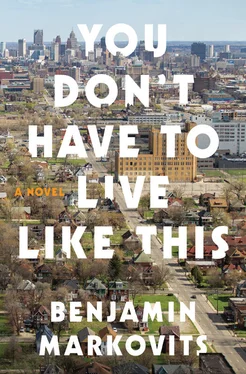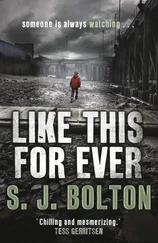I spotted Kurt Stangel, wearing a fat tie, and he came over to me and said in a low voice, “Have you seen Sean Penn?”
“Is he here?”
“They’ve got a documentary room, where people can go up and talk into a camera. Anyway, Eddie saw Sean hanging out there with Micky Dolenz.”
“What do you mean, Micky Dolenz?”
“What do you mean what do you mean ? The guy from the Monkees. All these LA types hang out together when they’re in town. You wanna go see?”
So we wandered out again, and on the way I picked up another beer. A guy in a pale gray pinstripe suit said, “Who’s running this show?” and somebody else said, “Robert James.”
“Who he?”
They were standing together by the drinks table, in everybody’s way, and when people pushed past they excused themselves very politely and didn’t move.
“One of these hedge fund types. He retired at like thirty and doesn’t know what to do with himself, so he does this.”
“Throw parties?”
Pinstripes had psoriasis on the back of his hands and kept scratching at it; the other guy was shorter and looked Jewish.
“No, this is just a publicity stunt. I mean, the whole neighborhood thing. Premature gentrification. He’s trying to get Obama’s attention.”
“So is he coming or not?”
“Don’t bet on it. He’s in Oslo for the Peace Prize.”
Then we got our beers and Kurt asked one of the waiters where the documentary room was. But it wasn’t a room. A kind of gallery overlooked the factory floor. There was a big open column of space in the middle of the building with a skylight on top made of small square panes. The afternoon light came in and fell like snow. You could hear the computers below giving off heat.
Somebody had put together an exhibition on the gallery walkway. (Later I met the guy, a German named Kellerman about my age, whom Robert had recently hired as artistic adviser. He dressed like a banker and spoke English English.) There were paintings and photographs on the walls, a lot of disaster kitsch, Detroit landscapes, burned-out houses and teddy bears in the snow. I found it depressing, the way artists go for this stuff, like it’s any more real than daffodils. There were also found-object displays and video installations, not just by professional artists but by some of the locals, too — mostly kids, with their names and grades and high schools labeled underneath. I looked out for Kettridge High but didn’t see it.
A long queue around one of the corners turned out to be the line for the documentary station. Kellerman had had the bright idea of inviting people to talk about what brought them to Detroit in the first place. So he set up a chair against one wall and pointed a camera at it. A chunky, short-haired woman in Doc Martens and a yellow floral dress kept people moving along.
I noticed Don Adler in the queue, but the rest of the crowd looked younger. The guy talking when we walked past said he graduated from the University of Chicago in 2005, then moved in with some friends who were renting a house by Wicker Park. For a while he lived off money from his dad, who worked for Aerotek in Maple Grove, Minnesota. His dad was an engineer, which was one of the reasons he studied engineering. But then his dad got laid off and couldn’t afford to send him pocket money. By this point he was willing to take anything and signed up to a call center agency. They found him a job at a travel insurance company, which had some vacancies in the night shift. This meant leaving the house at ten o’clock in the evening and coming back at eight a.m. Then he slept till lunchtime, but often overslept, and found himself wandering out to buy milk at four in the afternoon and feeling weird.
Meanwhile, he and one of the girls he lived with got engaged. She worked as a teaching assistant at a public elementary school in Evanston, but they didn’t have enough money to rent a place of their own and didn’t know anyone in Evanston to share a house with. The commute was about forty minutes each way and she found it draining. Even before they got married, which was last year, she became pregnant, and they needed to think of some other arrangement, not even to make their life tolerable, but just to make it feasible. After five minutes a light came on and it was somebody else’s turn to talk.
“Have you seen Sean Penn?” I said to Kurt, and he pointed.
It didn’t look like Sean Penn to me and then I realized it was probably Micky Dolenz. He was one of those fifty-year-old guys with a little boy’s face under the stubble and gray hair. Later I realized he was closer to sixty-five. Micky was sitting in front of a video installation, and Kurt and I took up a couple of empty seats in the row behind him. The video screen showed two women talking. One of the women was white and one was black, they were sitting on opposite ends of a brown couch, and suddenly I realized that the white woman was Astrid.
The credits rolled and then Micky got up and wandered off, but the piece was on a loop and I sat around to watch the beginning.
Kurt stuck around, too, and said, “The thing you have to realize about famous people is that they’re famous for a reason. Sean Penn is smarter than anybody you’ve ever met, he’s in better physical shape than anybody you’ve ever met, and he’s got more energy and intellectual curiosity about the world than anybody you’ve ever met. These people make things happen. He flies over to Haiti, and boom, a hospital gets built.
“There’s no wasted energy. If he’s hanging out with Micky Dolenz there’s probably a reason. Maybe he wants to make a Monkees movie. Not a remake, but a music-industry movie, about the whole publicity machine and the end of innocence. All of that crap. It’s not a bad idea. So he calls up Micky and says, I’m in Detroit, come, too.”
Astrid asked the black woman, “Do you remember when we first met?”
The woman shook her head and said, “I know who you are. I know what this is about. The only reason I agreed to this is because you paying me.”
“Would you like to talk about that? Would you like to mention how much you’re being paid?”
“I don’t like to talk about nothing. It’s your money, you axe the questions.”
“Do you remember when we first met?”
“I thought the Monkees was an LA thing,” I said to Kurt. “They were set up by the television studios.”
“Yes, but in 1967 they were supposed to play a concert in Detroit with Jimi Hendrix. But Jimi walked out and one of his publicists put it around that the Daughters of the American Revolution forced him off the tour.”
“I don’t think that’s why Micky Dolenz and Sean Penn are in Detroit.”
“You can’t make a movie about the American music business and not talk about Detroit.”
Astrid said, “What did you think when you saw me lying in your bed? For me, it was a very powerful moment. I was very scared, I didn’t know where I was, but to see a woman come in, after what had happened, made me think that what connects us as women is more important than nationality or race, it cuts through all that bullshit, when you came in, I knew it would be all right.”
“I didn’t do nothing but get rid of you.”
“You drove me to the bus station.”
“Well, if my brother came back I didn’t know what he’d do.”
There was a poster over the video screen that read A Conversation About Rape, with Astrid Topolski. Kurt said, “Listen, I’m gonna get another drink. This is downing me out.”
“Okay,” I said but after a few minutes stood up as well. Watching Astrid made me uncomfortable. As if I had done something wrong but didn’t know what — as if I had done something to her. Or maybe it was more like guilt by association. I went looking for Gloria.
Читать дальше












